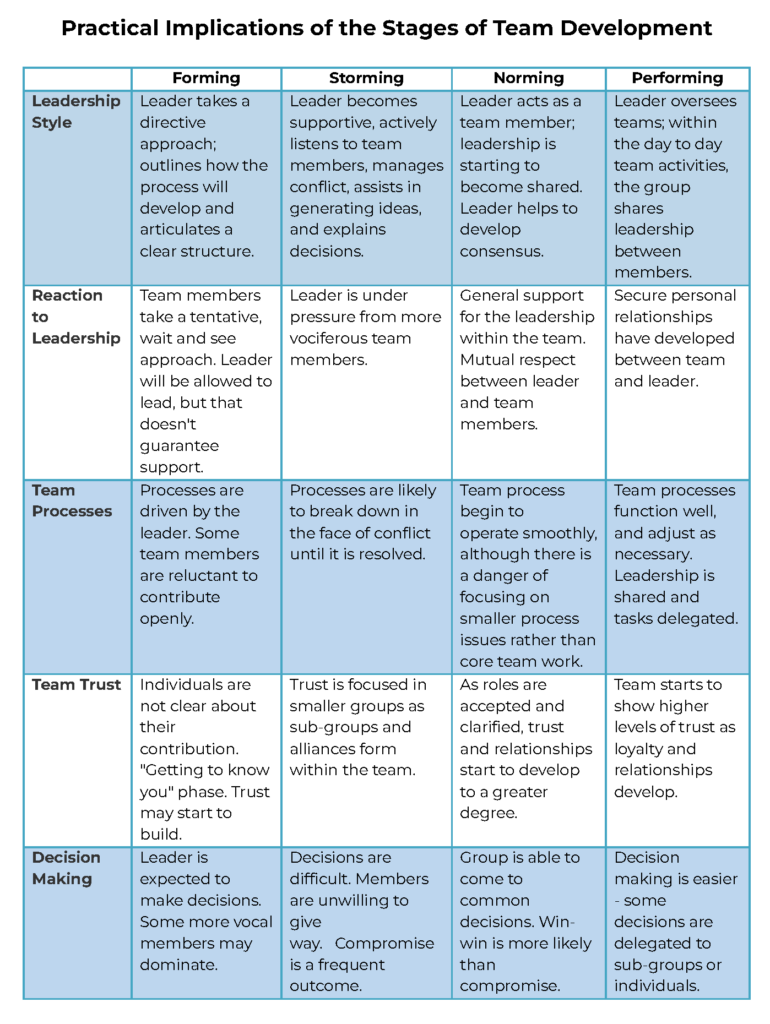The word team has been defined by Cohen and Bailey as “Groups of two or more people who interact and influence each other, are mutually accountable for achieving common objectives, and perceive themselves as a social entity within an organization”.[i]
In 1965, American psychologist Bruce Tuckman published an article called, “The Development Sequence of Small Groups” which described his perspective on the four stages of small group or team development. [ii] He recognized the distinct phases that teams go through and suggested they need to experience all four stages before they achieve maximum effectiveness. Tuckman’s model explains that as the team develops maturity and ability, relationships are established, and the leader changes his or her leadership style, beginning with a directing style, then moving through to coaching, and then participating, finishing and delegating. At this point, the team may produce a successor leader and the previous leader can move on to develop a new team. The ‘Forming – Storming – Norming – Performing’ theory has become a highly effective and generally well accepted explanation of team development and behavior. Tuckman refined the model in 1977 with the addition of a fifth stage called ‘Adjourning’. [iii]
Forming
In the Forming stage, team members are getting to know one another and getting comfortable with one another. Members will naturally try to understand their own roles, the roles of the other team members and their purpose in the group. This is entirely natural and to be expected. People are unsure, suspicious and nervous. There is a high dependence on the leadership for guidance and direction. You’ll find little agreement on team aims other than those that are received from the team leader. Individual roles and responsibilities are unclear, and processes are often ignored. Your team members will test the tolerance of the system and of you.
In this phase, leaders should:
- Help team members get to know one another.
- Make sure the purpose and tasks are clearly defined and share management expectations with the group.
- Give the team time to get comfortable with one another, but move the team along as well.
- Be prepared to answer lots of questions about the team’s purpose, objectives and external relationships.
Storming
Storming is the most difficult stage for a team to weather, but it is necessary for healthy team development. When your team members begin to trust one another enough to air differences, this signals their readiness to work things out. Decisions don’t come easily within a group. Team members vie for position as they attempt to establish themselves in relation to other team members and you. The clarity of purpose may increase but plenty of uncertainties will persist. Cliques and factions among team members will form and there may be power struggles. Your team will need to be focused on its goals to avoid becoming distracted by relationships and emotional issues. Compromises may be required to enable progress.
In this phase, leaders should:
- Acknowledge it with the team as a natural developmental step.
- Surface the conflicts and address them.
- Review ground rules, revisit the purpose and related administrative matters of the team.
Norming
Beyond the politeness and nervousness of Forming and past the issues and concerns of Storming, teams will want to review how they are functioning. As team members learn to work out their differences and emotional conflicts are reduced, they will have more time and energy to focus on their purpose. In this phase, your team will have PROCESS down fairly well. TASK will take on new significance as your team will want to accomplish its purpose. Agreement and consensus is largely formed among the team, who will respond well to your facilitation. Roles and responsibilities are clear and accepted. Big decisions are made by consensus and smaller decisions may be delegated to individuals or small teams within the group. Team commitment and unity will be strong and the team may engage in fun social activities. Your team will discuss and develop its own processes and working style. At this stage there will be general respect for your leadership.
In this phase, leaders should:
- Remind the team of the task.
- Be more diligent in adhering to the road map, providing time for feedback, closure, etc.
- Facilitate and enable.
Performing
Performing teams are just that, a highly effective, problem-solving unit that can reach solutions quickly and can even head off issues before they become problems. Teams at the performing level are generally self-regulating. Road maps, processes, decision making and other matters of team management will be handled independently by the team. At this stage, your team will be more strategically aware; your team will know clearly why it is doing what it is doing. Your team has a shared vision and is able to stand on its own without your interference or participation.
Your team will have a focus on over-achieving goals, and will make most of the decisions against criteria agreed with you as the leader. Your team will have a high degree of autonomy. Disagreements may occur, but now they will be resolved within the team positively and necessary changes to processes and structure are then made by the team. At this point, your team will be able to work towards achieving the goal, and also to attend to its relationship, style and process issues along the way.
In this phase, leaders should:
- Provide delegated tasks and projects to the team. The team does not need to be instructed or assisted.
- Provide assistance to team members as needed.
- Leader delegates and oversees.
Adjourning
The final stage is adjourning. The group may cease to exist because they have met their goals and are no longer needed. Other groups may adjourn norms that have developed and are no longer effective for the group.
The adjourning stage involves the termination of task behaviors and disengagement from relations-oriented behaviors. Some groups, such as a project team created to investigate and report on a specific program within a limited time frame, have a well defined point of adjournment. Other groups, such as an executive committee, may go on indefinitely.
Teams do not develop as neatly and sequentially as these stages imply. Teams can cycle from one stage to another relatively easily or get stuck in one stage. Also, as shown above, team development does not tend to be linear; instead it is most often cyclical.
The real value is in recognizing where a group is in the process and helping it to move to the Perform stage. In the real world, groups are often forming and changing, and each time that happens, they can move to a different stage. A group might be happily Norming or Performing, but a new member might force them back into Storming. Seasoned leaders will be ready for this, and will help the group get back to Performing as quickly as possible.
References
[i] S.G. Cohen and D.E. Bailey, “What makes teams work: Group effectiveness research from the shop floor to the executive suite,” Journal of Management, 23, May 1997, pp. 239-90.
[ii] Tuckman RW (1965). Developmental Sequence in Small Groups. Psychological Bulliten, 63(6); 384-99.
[iii] Tuckman RW and Jensen M (1977). Stages of small group development revised. Group and Organizational Studies; 2:419-27.


